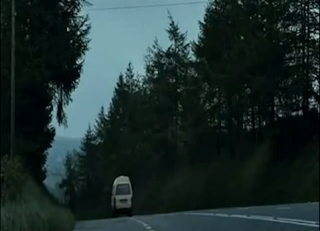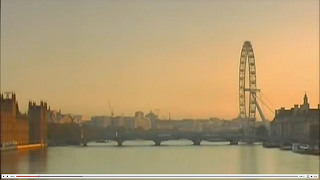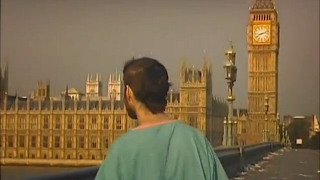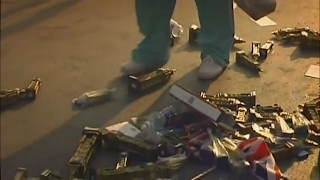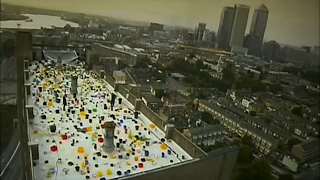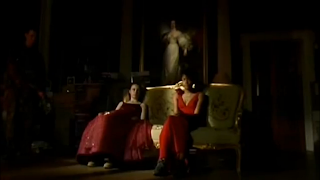Point 1: Bedroom every night
Camera Angles:
High angle of the bed every night showing it's vulnerability (even though they are in their own house) Very loose framing around the bed highlighting the space around the bed and the fact that they are alone making them vulnerable.Editing:
 'Night vision' on at night, the audience can see more than the characters in the movie, therefore giving the audience more knowledge. Building tension when the couple fall asleep and the audience are 'still awake' creates a sense of fear.
'Night vision' on at night, the audience can see more than the characters in the movie, therefore giving the audience more knowledge. Building tension when the couple fall asleep and the audience are 'still awake' creates a sense of fear.The time at the bottom of the screen goes fast, showing that the footage has been sped up. When the time is slowed down again the audience know something noteworthy has happened and this increases their fear. Also, the time being recorded at the bottom of the screen makes the events seem more real and heightens the fear.
Sound:
Usual conversation, relating to the audience showing that it could happen to anyone, these people are also ordinary. The sound throughout the night scenes also consists of a lot of silence and this is effective asMise En Scene:
Bed sheets are white, suggesting the innocence the couple have to spirits and demons and the fact that they are ignorant about it. Same shot of the bed every night, creates a pattern for the audience as the movie goes on, night time will signify fear and they will recognise it is when the demon attacks.The lighting is a clinical blue and this gives the idea that the demon does not cause terror for a passionate and personal reason and this makes the audience more scared. Also, the audience will recognise the blue lighting everytime it is night and associate it with the unusual goings on.
Point 2: Hand prints on the floor
Camera Angles:
Birds eye view of the hand prints, this linked with the frequent canted shots we see of them emphasises that the events are being home-videoed and makes it seem more real and threatening. The canted shots also imply anxiety.Editing:
During the slip the camera is being moved around from above and is not stationary or steady- this emphasises how the characters are holding the camera and makes the events seem even more real. It also shows how they are completely alone as there is no camera crew and this makes them seem even more at threat.
 Sound:
Sound:
We hear the female protagonists' diegetic voice sounding distressed and repeating "Oh God" and this increases the unease of the audience as they are made to feel the same as the characters. It also makes them aware that the occurrence is unusual and to be feared.
Mise En Scene:
Brown floor suggests protection, the white hand prints are breaking it up and taking the only protection the couple have away from them. Gives the demon a form, confirms it's presence in their house and increases the terror. The fact that it looks more like hand prints than foot prints makes the demon resemble animal traits and seem like something we are not used to- this increases the fear of the force as we tend to be more afraid of the unknown. Also, by having the hand prints obviously go in a trail towards their bed it shows the direct threat that the characters are in.Point 3: Body thrown against the camera
Camera Angles:
The body comes directly towards the camera and this makes the audience feel threatened as it is though it is being thrown at them.Editing:
 Jump cuts of various scenes throughout the media, such as the ouija board, gathering speed to build the tension before the body is thrown. The scene is quick and the audience are not sure whether they have seen it properly or not. Straight after the event there is a jump cut of a static TV screen which gives the impression that the camera has broken and the audience will never know the end of the story. We also see cutaways of the audience and their terror which heightens the audience's fear as they feel like they haven't been shown all that the audience can see and that they should be afraid.
Jump cuts of various scenes throughout the media, such as the ouija board, gathering speed to build the tension before the body is thrown. The scene is quick and the audience are not sure whether they have seen it properly or not. Straight after the event there is a jump cut of a static TV screen which gives the impression that the camera has broken and the audience will never know the end of the story. We also see cutaways of the audience and their terror which heightens the audience's fear as they feel like they haven't been shown all that the audience can see and that they should be afraid.Sound:
There are regular crashing symbol sounds getting faster alongside the montage of clips which also helps build tension as the audience expects something bad to happen. The sound is also dischordant and loud making it uncomfortable to hear and this emphasises the audience's unease watching the unravelling events.Mise En Scene:
The camera footage is the only thing the people can use to view the events of the movie so by being destroyed it could potentially cut off the audience and leave them without knowing the ending creating an uneasy ending. The familar blue lighting is used to indicate to the audience that something bad will happen. We can't see the male protagonist's face and this creates a sense of curiosity as we can't see what has happened to him. We are also made frustrated as the angle of the camera means we can't see what or who has thrown him towards us.Point 4: Hand held camera
Camera Angles:
Low angle of the man holding the camera, this strange angle when the man is holding the camera emphasises that we are watching the camera which is filming. We see the camera face-on through the mirror showing the audience what is actually filming and making it seem more real.
 Editing:
Editing:
This shot comes as a collective montage of clips which show the audience the characters, their personalities and the setting briefly so they know what to expect. This is effective as by familiarising the audience with the protagonists and the setting which happens to be their home, they become much more attached and feel more upset and scared when the demon starts to attack.
Sound:
Diegetic sound of the camera rolling as well as conversation- this adds to the realism of the movie which links in with the fact that we can see the camera which is filming what we are seeing. The continuous clicking of the camera rolling also creates tension as it builds up.Mise En Scene:
Either side of the shot we can see the frame of the mirror and this not only symbolises how the characters are trapped within their fate but also along with the coats on the hangers makes the shot seem incredibly everyday- this makes the audience empathise with the characters more and increases the tension in the more scary scenes. This is an effective method used at the beginning of the movie or trailer when the audience are being introduced to the characters.To conclude, the setting of home is incredibly effective as the threat being inside the home of the characters gives the audience the unsettling feeling that there is nowhere for the characters to hide. It is also effective having the familar and intimate feel of the home deteriorate over the period of the movie through various methods.
